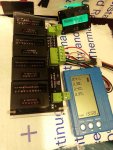I have a Renogy 20a DC-DC charger connected to a Battleborn 100Ah battery and a Victron 712 to monitor the system.
While we're driving around a lot, the battery does not seem to charge back up to full and stops charging soon after the car Is started. Voltage builds up to 14.4v pretty quickly, with corresponding 20A charge, then stays at 14.4v but does not draw any current. Once the vehicle is turned off (or the battery isolated from the charger) the voltage drops back down (currently to 13.00v).
As an example, today we drove 2 hours but it was only drawing a current for the first 10-20 minutes. I then stopped for an hour, turned some lights on for a few minutes and started the engine again. The battery was drawing 20A, but stopped about 30 seconds later, once voltage hit 14.4v (voltages verified across battery terminals with voltmeter).
The "final" voltage has been dropping each trip I do (done 3 so far). While I don't necessarily expect the battery to charge back to full ever time, I'd expect it to charge fully based on current usage (3-4 hour drive a day ~10-20A usage at night).
The Renogy charger is set to LiPo mode, with bulk/absorption set to 14.4v (14.40-14.45v measured) and no float. The battery settings for the 712 are based on Battleborns own suggested numbers (see image).
I also had a rather odd situation just now. Battery was at 12.98v (which is around 20% SOC?), turned the lights on and a few minutes later the 712 was showing 13.28v (verified with voltmeter). Once the engine was turned on shot up to 14.4v, then once turned off it dropped down to 12.98v again.
Does anyone have any suggestions as to what the problem is?
While we're driving around a lot, the battery does not seem to charge back up to full and stops charging soon after the car Is started. Voltage builds up to 14.4v pretty quickly, with corresponding 20A charge, then stays at 14.4v but does not draw any current. Once the vehicle is turned off (or the battery isolated from the charger) the voltage drops back down (currently to 13.00v).
As an example, today we drove 2 hours but it was only drawing a current for the first 10-20 minutes. I then stopped for an hour, turned some lights on for a few minutes and started the engine again. The battery was drawing 20A, but stopped about 30 seconds later, once voltage hit 14.4v (voltages verified across battery terminals with voltmeter).
The "final" voltage has been dropping each trip I do (done 3 so far). While I don't necessarily expect the battery to charge back to full ever time, I'd expect it to charge fully based on current usage (3-4 hour drive a day ~10-20A usage at night).
The Renogy charger is set to LiPo mode, with bulk/absorption set to 14.4v (14.40-14.45v measured) and no float. The battery settings for the 712 are based on Battleborns own suggested numbers (see image).
I also had a rather odd situation just now. Battery was at 12.98v (which is around 20% SOC?), turned the lights on and a few minutes later the 712 was showing 13.28v (verified with voltmeter). Once the engine was turned on shot up to 14.4v, then once turned off it dropped down to 12.98v again.
Does anyone have any suggestions as to what the problem is?



